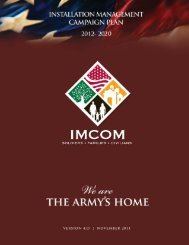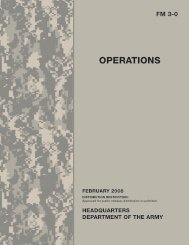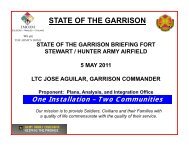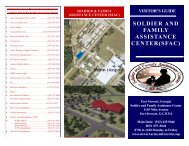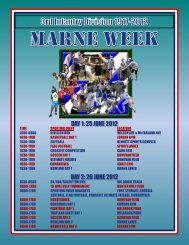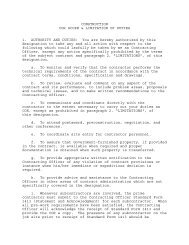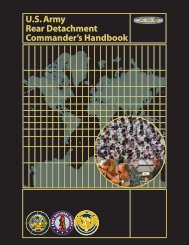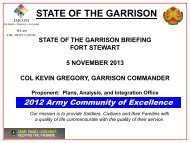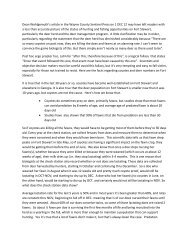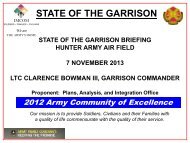3rd Infantry Division Operations - Fort Stewart - U.S. Army
3rd Infantry Division Operations - Fort Stewart - U.S. Army
3rd Infantry Division Operations - Fort Stewart - U.S. Army
Create successful ePaper yourself
Turn your PDF publications into a flip-book with our unique Google optimized e-Paper software.
80 <strong>3rd</strong> <strong>Infantry</strong> <strong>Division</strong> <strong>Operations</strong><br />
risons and stations, Joint Security Stations (JSS), and patrol<br />
bases. Confidence, competence, and capabilities grew over<br />
time from continuous operations and training. Understandably,<br />
shared sweat and danger inspired mutual respect and admiration<br />
among soldiers from both armies.<br />
The 8th Iraqi <strong>Army</strong> in the south, the 4th Brigade of the 6th<br />
Iraqi <strong>Army</strong> nearer Baghdad, and the 1st National Police Brigade<br />
east of the capitol improved their capability every day.<br />
The Iraqi people responded positively to their soldiers and the<br />
return of authority to their military forces. Doubt and skepticism<br />
was replaced with confidence and pride. Tribal elders met<br />
and settled disputes peacefully and then allied security forces<br />
against extremists. Young men formed long lines to volunteer<br />
their service. Citizens provided tips and intelligence. Since<br />
Iraqi security forces were taking more of a role, it was possible<br />
to release some former combatants into the general population.<br />
Freed detainees returned to their communities under the watchful<br />
eyes of tribal “guarantors” who ensured that they would not<br />
return to their criminal ways.<br />
In February and March, millions of pilgrims streamed to<br />
the holy cities of Najaf and Karbala in peaceful celebration of<br />
Islamic holidays. Attack rates on Iraqis and coalition forces<br />
dropped from a high of 25 per month in May to under five per<br />
month. By March of 2008, the rate of effective attacks against<br />
coalition forces was near zero.<br />
Iraqi soldiers and police formed long lines at coalition-run<br />
military schools. Aligned with brigade combat teams, scores of<br />
Iraqi soldiers competed for the opportunity to train under their<br />
counterparts – American officers, NCOs, and Soldiers. Culturally,<br />
few armies in the world place as much value on the role<br />
of NCOs as the services of the U.S. military. The Task Force<br />
Marne NCO Academy opened in February to imbue each Iraqi



